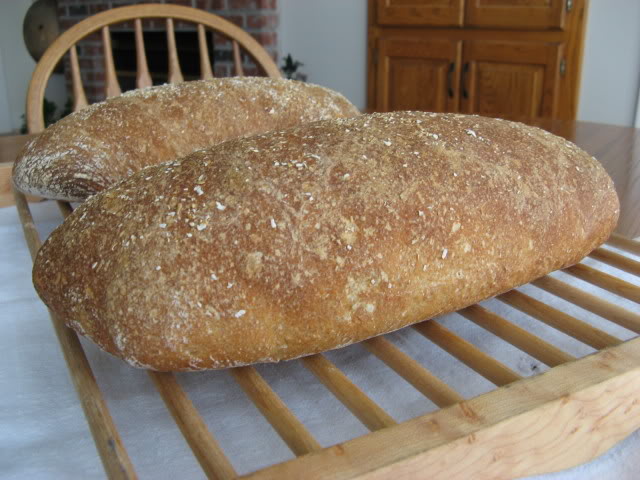Today's bake was Daniel Leader's Whole Wheat Genzano Country Bread, from his Local Breads book. This bread combines a biga naturale for flavor with yeast for shorter, more predictable fermentation times.
The formula is straight-forward: the biga, water, equal parts whole wheat and bread flours, salt and yeast. Final hydration works out to about 77%. Based on Leader's description of the dough, I was expecting something almost in the ciabatta realm. It turned out to be less gloppy than a ciabatta dough, perhaps because of the extra absorbency of the whole wheat flour. Still, it was definitely better handled by the mixer than by hand. I'm a little leery of his mixing directions, though. First, he recommends an 10-minute run at speed 8 on a Kitchen Aid, followed by an 8-10 minute run at speed 10. I didn't run it quite that long, or quite that fast, since I was seeing good gluten development. Plus, the dough was clearing the sides of the bowl, even though it was very sticky. The directions indicated that it probably cause the mixer to walk. Hah! I had to hold it down, what with the ball of dough slapping and releasing from the sides of the bowl.
After the mixing/kneading stage, the dough is dumped into an oiled container for 1-1.5 hours until it doubles. It is then treated to a series of stretch and folds in the container (I used a plastic bowl scraper for this exercise), then allowed to double again. Having finished bulk fermentation, the dough is scraped out onto a floured counter, divided in two, and (very gently) shaped into rough, rectangular loaves that are placed on bran-strewn pieces of parchment paper for their final rise. The risen loaves go onto stone in a preheated oven, with steam. The initial temperature is 450 F, which is dropped to 400 F for the second part of the bake. Oven-spring was good. The crust color is a deep brown, but not the near-black color promised in the formula.
The finished bread looks like this:

The crust is thin and crackly, although I expect it will soften because of the internal moisture. The flavor is very good; closer to that of a yeasted bread than to a sourdough but with some complexity that isn't usually present in a straight dough. There doesn't seem to be the bitterness that sometimes shows up in whole wheat breads. The crumb is moderately open, though nothing like the big holes of a ciabatta. That's not bad, since this will be used primarily for sandwiches. The breads are relatively light in weight for their size, another indicator of an open crumb. I'll have to get a crumb shot, later.
I will definitely make this again, although I may experiment with leaving out the yeast. That should swing the flavor profile in a whole 'nother direction. Before getting to that, though, I have my eye on a couple of different rye recipes from Local Breads.
Paul











